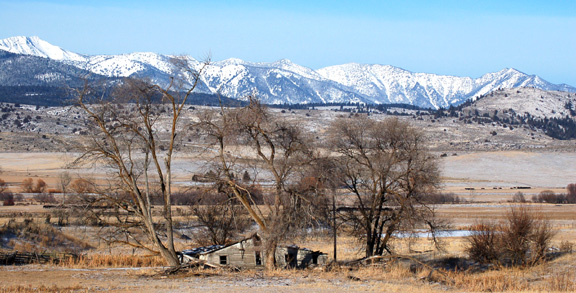- Cole Case Developments [Edited 4/22/10]
- Some Baker County Birds (Spring Arrivals)
________________
COLE CASE-- Defense Attorney J. Robert Moon, Jr. Files MEMORANDUM IN SUPPORT OF DEFENDANT'S MOTION TO SUPPRESS [Evidence]
The sluggish legal process made a significant lurch forward this week in the Brian Cole sexual abuse case, when his attorney filed a motion to toss out essentially all the significant evidence. Cole, a former Economic Development Director, consultant, former County Commissioner, and former Nazarene Sunday school teacher, has been accused by the State of Oregon "of four counts of sexual abuse in the third degree (Class A misdemeanors) and two counts of providing liquor to a person under 21 (Class A misdemeanors)."
Wednesday, April 14, 2010, Bob Moon, a premier defense attorney here in Baker City, filed a motion with our Circuit Court to suppress (exclude) the most important and damaging evidence produced by the prosecution in the case--beginning with information gathered at the time of initial law enforcement contact at the Rural Fire Protection District property on Pocahontas Road. Alleging that the stop was illegal, Moon then claims that "all other evidence derived from" the evidence obtained during the stop, must be suppressed.
While attorney Moon's "facts" and and legal theories in support of Cole's defense have yet to be responded to by the prosecution, presented below is the text from pages 1 through 7 of his memorandum, which encompasses the "facts" from the defense perspective, and the text from pages 18 & 19, which offer the defense's conclusions. As I am not a lawyer, and as his arguments in pages 7 through 18, have not yet been responded to by the prosecution, it seemed to me less that helpful for the pursuit of justice, to include them here without rebuttal from the prosecution. I have removed the numerous references to the alleged victim and her family, by placing in brackets "[]" other references, such as [the 17 year-old minor].
It was surprising to me that while the press is properly admonished to protect the identity of alleged juvenile victims, the courts and defense attorneys have no such qualms. In fact, Attorney Moon's memorandum seems to go out of its way to reveal the victim's identity, not that many do not already know. In following up on this question, I have found the Oregon state agencies in Salem less than forthcoming. Generally, a minor is someone under the age of 21, and a juvenile is a person under the age of eighteen. [Corrected on my own edit 4/22/10] In this case, the alleged sex abuser, was 47 at the time of the incident. The alleged victim was 17 years old.
The most relevant portion of the defense's argument is that:
"The October 31,2009, contact between Deputy Maldonado and Brian Cole was a "stop" without legal justification and was thus illegal. From this illegal stop the state obtained evidence of furnishing alcohol to a minor. The state used this iIIegally obtained evidence to secure a November 3, 2009, warrant for [the minor's] messages from October 30, 2009, to November 1, 2009, even though that application only established probable cause to believe that evidence of "furnishing aicohol to a minor" would be found in a single phone call and text message that occurred on October 31,2009."
Following up, the defense then presents the "Fruit of the Poisonous Tree" argument that "Any and all evidence derived from an unreasonable search and/or seizure must be suppressed as "fruit of the poisonous tree."
Beyond that, basically, the defense contends that because in their view, the check on suspicious activity at an out of the way rural fire department was "illegal," then most of the evidence gained from statements made during the stop are inadmissible, and that because the defendant was not read his "Miranda" rights, even though no arrest took place, anything he said should also be inadmissible. They further contend that, in order to find incriminating evidence, the State Police used "coercive techniques" to gain information from the alleged victim, and used unjustified illegal searches to gain access to "sexually-suggestive" text messages between her and the defendant, Brian Cole. The evidence included what the state described as "sexually explicit text messaging." The state also contends that the alleged victim's father had no right to consent to the search of his juvenile daughter's computer, which revealed a "personal journal" with statements that led the state "to conclude that [the alleged victim] had a romantic relationship with Brian Cole."
Here is the text of the portions of the motion minus the laborious and legalistic arguments:
"MEMORANDUM IN SUPPORT
OF DEFENDANT'S MOTION
TO SUPPRESS
I. FACTS
On October 31, 2009, at approximately 8:15 p.m. Baker County Sheriffs Deputy Travis Ash drove past the Baker Rural Fire Department (BRFD) station located about two miles west of the Baker City limits on Pochahontas Road. He noticed a car parked underneath a light in the BRFD's parking lot. At that time, Ash was handling another matter of urgency, so he called Baker County Sheriffs Deputy Gabe Maldonado on his cell phone and asked Maldonado to check on this parked car. At the time, Maldonado was finishing a traffic stop on Hwy 30, but after finishing that stop he drove to the BRFD.
Maldonado arrived at BRFD at approximately 8:33 p.m. with his overhead lights on. According to his police report, he pulled into BRFD's parking lot where he saw a white four-door Volkswagen backed into the end of the gravel parking lot facing Pochahontas Road with it's lights off and he noticed the ·car had no front license plate. Maldonado saw that the car had two people in it. Maldonado reported that the man looked startled. Maldonado says he saw a younger-looking female and he thought the two of them were passing something between them because they were both looking down towards the center console. Maldonado parked in front of the Volkswagen and turned on his vehicle spotlight. He reported to dispatch that he was on a "traffic stop ... no front plate." Maldonado then says he saw the driver sit back in his seat, place his left elbow on the driver's door and lean his head on his left hand.
Maldonado approached the Volkswagen on the driver's side door and the driver identified himself as Brian Cole. Maldonado asked Cole for identification and Cole gave Maldonado his license. Maldonado then asked the passenger to identify herself and she said she was [. . . .]. She then told Maldonado her date of birth and he determined that she was 17 years old. During the conversation Maldonado could detect an odor of alcohol. Maldonado then asked Cole to step out of his car. At that time, Baker County Sheriffs Deputy Rich Kirby arrived at the fire station. When Cole got out of his car Maldonado reported that Cole said "I know this doesn't look good." Cole explained that the [17 year-old minor . . .] was unhappy with her performance and they were sitting there talking about it.
Maldonado told Cole that he could smell alcohol and Cole said, "I've had a few sips, but that's all." When asked whether [the 17 year-old minor] had been drinking Cole said, "I don't know. I don't think so." Cole said that he and [the 17 year-old minor] had not been doing anything else in the car and that a bottle of schnapps was in the car. Maldonado asked Cole if he would consent to the search of his car and Cole agreed. Maldonado then explained the situation to Kirby. They decided that Kirby would further question Cole, and Maldonado would talk to [the 17 year-old minor].
Kirby asked Cole what he was doing there with the 17 year-old minor. Cole explained that [the 17 year-old minor] . . . had a bad day that day, so they were at the fire siation talking. Kirby asked how the two of them had gotten together that night and Cole could not remember whether he called her or whether she called him. Cole told Kirby that he picked[ the 17 year-old minor] up near his office in downtown Baker City and that she was in the vehicle when he went into his office and grabbed the bottle of schnapps.
[The 17 year-old minor] explained to Maldonado that she was walking around Baker City when Cole called her. She looked at her cell phone and told Maldonado that Cole called her at 7:47 p.m. that evening. Maldonado asked her where she was going when Cole called her and she said she was just on a walk . . . . Maldonado asked [the 17 year-old minor] how she would describe her relationship with Cole and she said they were "friends, that's it."
[The 17 year-old minor] said Cole is ". . . ." The 17 year-old minor then admitted taking a "couple of sips" of the schnapps.
[The 17 year-old minor] told Maldonado that the schnapps were undemeath her seat. Maldonado
then searched Cole's car and found the schnapps bottle.
Maldonado then asked Cole how he and [the 17 year-old minor] got together that evening and Cole said that he picked [the 17 year-old minor] up. Maldonado asked if Cole called [the 17 year-old minor] or if [the 17 year-old minor] called Cole and Cole said "I don't know," but he then thought about it further and said, "I texted her."
Cole was then issued a citation for furnishing alcohol to a minor and was told he was free to leave. [The 17 year-old minor] was transported to the Baker County Sheriffs office by Deputy Kirby where she was cited for minor in possession of alcohol. While at the Baker County Sheriff's office waiting for her parents to arrive, Kirby noticed that she was text messaging someone. Shortly afterwards, [the 17 year-old minor] was released to her
mother . . . .
The police involved in this investigation were likely still very suspicious that some type of illicit relationship existed between Cole and [the 17 year-old minor], so the next day on November 1, 2009, Deputy Ash determined that [the 17 year-old minor]'s cell phone number was . . . . and Brian Cole's cell phone number was . . . . Ash then wrote letters to their respective cell phone companies requesting that those companies preserve all text and voice messages associated with these numbers. Ash indicated in these letters that "the incident date began on 10-31-09 and is still ongoing."
Also that day the Oregon State Police's major crime unit began investigating this case and OSP Sergeant Ty Duby asked OSP Detective Dave Aydelotte to work on this criminal investigation of Brian Cole. On November 2,2009, Aydelotte went to [the 17 year-old minor's] home in Baker City and met with her father . . . . Her Father told Aydelotte that he provides a cell phone to his daughter, . . . , through a family plan at U.S. Cellular and that he pays the bill on this account. [The father] told Aydelotte that he knew the [17 year-old minor's ] phone had been working on October 31, 2009, but on November 1 they were unable to get the phone to stay on.
A U.S. Cellular representative told [the father] that the phone had been water damaged. Aydelotte asked [the father] for consent to obtain the cell phone records from [the 17 year-old minor]s account, including text messages. [The father] agreed and signed a "consent to search" form. He also told Aydelotte that [the 17 year-old minor] had a Dell laptop computer that was paid for by both him and [the 17 year-old minor].
On November 3, 2009, Aydelotte applied to the Baker County Justice Court for a search warrant to obtain the cell phone records, including text messages, from [the 17 year-old minor] and Cole's cell phones. Aydelotte indicated in his search warrant affidavit to Justice of the Peace Lise Yervasi that he was investigating the crime of providing liquor to a person under 21. Aydelotte said in his affidavit that on Saturday, October 31, 2009, Brian Cole was cited for furnishing alcohol to a minor, 17-year-old [minor]. Aydelotte indicated that Cole admitted texting [the 17 year-old minor] to pick her up that evening and that [the 17 year-old minor] admitted that Brian Cole called her at 7:47 p.m. that evening. Aydelotte asserted that he had probable cause to search both Brian Cole's cell phone records and [the 17 year-old minor]'s records for the crime of furnishing alcohol to a minor and, based on that assertion, Judge Yervasi authorized the search of all of the cell phone records for both Brian Cole and [the 17 year-old minor] for the timeframe of between October 30, 2009, through November 1,2009. The warrants were served later that day. The records were provided to Aydelotte on November 5, 2009. The records from Brian Cole's cell phone contained no text messaging between Cole and [the 17 year-old minor]. However, Aydelotte reviewed the text message records captured on [the 17 year-old minor]'s phone and found sexually-suggestive texts that he thought were exchanged between [the 17 year-old minor] and Brian Coie on October 30,
2009.
On November 11, 2009, Sergeant Duby and Detective Aydelotte interviewed [the 17 year-old minor] at Baker City's Oregon State Police office. After what can only be described as a very coercive interview, [the 17 year-old minor] denied having any sexual contact with Brian Cole, but acknowledged that they exchanged text messages where they described sexual scenarios to each other.
On November 22, 2009, Aydelotte applied for another search warrant in the Baker County Justice Court. Aydelotte described what he thought was sexually-explicit text messaging that was exchanged between [the 17 year-old minor] and Brian Cole that he had obtained from [the 17 year-old minor]'s cell phone records. He acknowledged in this application that [the 17 year-old minor] was 17 years of age. He swore that probable cause existed to search Brian Cole's home, office and person for electronic equipment for the crime of "online sexual corruption of a child in the first degree" under ORS 163.433.
Aydelotte then asked for a warrant to search Brian Cole's home, office and person for electronic equipment for that crime. Then, without any grounds to believe that [the 17 year-old minor]'s computer would also contain evidence of online corruption of a child in the first degree, Aydelotte asked for a warrant to seize her computer as well. Despite online sexual corruption of a child in the first degree defining "child" as a person the defendant reasonably believes to be under 16 years of age (see ORS 163.431(1)) and having no grounds to believe that evidence of that crime would be on [ the 17 year-old minor]'s computer, Judge Yervasi signed a warrant authorizing the search of [the 17 year-old minor]r's computer.
[The 17 year-old minor]'s computer had her personal journal that Detectives Aydelotte and Duby were able to review. The journal had entries that led Duby and Aydelotte to conclude that [the 17 year-old minor] had a romantic relationship with Brian Cole. Duby and Aydelotte then re-interviewed [the 17 year-old minor] on December 3, 2009. Aydelotte and Duby confronted [the 17 year-old minor] with several journal entries. She first explained that these were short stories that she was making up. Then, in what can only be described as an incredibly coercive interview, [the 17 year-old minor] indicated that Brian Cole had
touched her several times sexually.
Sometime thereafter, a Baker County grand jury convened to consider this case. [The 17 year-old minor] testified at this grand jury and likely testified that Brian Cole provided her alcohol on January 1, 2009. The grand jury did not deliberate in this case. Rather, on February 10, 2010, Special Baker County District Attorney Sean Riddell filed an Information accusing Brian Cole of four counts of sexual abuse in the third degree (Class A misdemeanors) and two counts of providing liquor to a person under 21 (Class A misdemeanors).
III. CONCLUSION
The October 31,2009, contact between Deputy Maldonado and Brian Cole was a "stop" without legal justification and was thus illegal. From this illegal stop the state obtained evidence of furnishing alcohol to a minor. The state used this iIIegally obtained evidence to secure a November 3, 2009, warrant for [the 17 year-old minor]'s text messages from October 30, 2009, to November 1, 2009, even though that application only established probable cause to believe that evidence of "furnishing aicohol to a minor" would be found in a single phone call and text message that occurred on October 31,2009.
From these illegaily-obtained text messages, Troopers Duby and Aydelotte interviewed [the 17 year-old minor] on November 11, 2009. [the 17 year-old minor] disclosed no sexual contact between her and Brian Cole, but she gave Aydelotte additional information that he used to obtain a November 22, 2009, warrant to search [the 17 year-old minor]'s computer. Of course, in this November 22, 2009, application Aydelotte swore that he had probable cause to search for the crime of "Online Corruption of a Chiid" when he knew or should have known that a "child" was defined as a person reasonably believed by the defendant to be under 16 years of age when, in fact, [the 17 year-old minor] was 17.
This illegal search disclosed to the state [the 17 year-old minor]'s personal journal that they used as leverage, along with other coercive techniques, to eventually get [the 17 year-old minor] to declare that Cole had engaged in sexual contact with her. Under these facts, the state cannot prove that they would have obtained evidence of this sexual contact (or evidence of the January 1, 2009, furnishing alcohol to a minor) "independently" or "inevitably," so this court should declare that all evidence obtained by the state in this case was "fruit of the poisonous tree" and order it suppressed.
Brian Cole should have been given Miranda warnings on October 31, 2009, Also, statements made by Brian Cole to the police that day where made after an illegal stop. For those reasons, his statements should be suppressed and any consent he
gave should be deemed invalid as involuntary. Finally, this court should rule that Cole has a privacy interest in his text messages, which could not be overcome by [the father]'s consent. So, evidence obtained from [the 17 year-old minor]'s cell phone records should aiso be suppressed by this court.
RESPECTFULLY SUBMITTED this 14th day of April, 2010.
J. Robert Moon, Jr. OSB#81322
Attorney for Defendant"
__
See Also:
Baker County Blog: 1) Western Wildlife and 2) New Cole Hearing Set
Mar 30, 2010
Odds & Ends: Brian Cole Case and Environmental Issues
Feb 18, 2010
Hells Canyon Early Spring Wildflowers (also, Brian Cole Case)
TUESDAY, MARCH 9, 2010
Halloween Happenings: Brian Cole Cited for Furnishing Alcohol to a Minor
Last update 8:50 PM, 11/3/09.
__________
Some Baker County Birds (Spring Arrivals)
 Baker County in March
Baker County in MarchLots of Baker County birds have returned since February. Hard to know where to start. How about February? Only a few here, the rest for another blog.
Horned Larks
I began to see these sometime year-round residents in late February and early March. They were quite common in small groups or pairs by March 15th, in often windswept bare ground and sagebrush country, from Shetky Road north of Highway 203 and on to the east. It is said to be an early nester, with Gabrielson & Jewett (Birds of Oregon, 1940) putting the dates as between April 3, and June 20. Gabrielson & Jewett wrote that horned larks used to exist here in "great wintering flocks."although I have not seen them. The "streaked horned lark" of the west side of the state, much reduced in numbers, was recently featured on an edition of PBS's "Oregon Field Guide."
 Horned Lark, Eremophila alpestris, Schetky Road, May 11, 2008
Horned Lark, Eremophila alpestris, Schetky Road, May 11, 2008Red-tailed Hawks (Buteo jamaicensis), the most numerous of our raptors, are nesting now in the larger trees in Baker County (as are the Great-horned and Barn Owls, except that the Barn Owls are more often found in small cliff caves, barns and manufactured owl boxes).
 Red-tailed Hawk, Beaver Creek, 2/26/09
Red-tailed Hawk, Beaver Creek, 2/26/09 Adult Red-tail, Stall Road, 12/27/09
Adult Red-tail, Stall Road, 12/27/09 Red-tailed Hawk nesting on Sunny Slope Rd., April 26, 2010
Red-tailed Hawk nesting on Sunny Slope Rd., April 26, 2010Osprey
Another almost common raptor in Baker County is the Osprey--also known as the Fish Hawk. At the time "Birds of Oregon" was written in 1940, the Osprey had been in serious decline in Oregon. Today, due to various efforts, including the placement of nesting platforms near fish-bearing water, they are doing well. Platforms with nests can be found along Highway 7 at Hudspeth Road and a mile or two further west. There is another on Wingville Road near Highway 30, another on the east side of the "UPS/Freeway ponds," and another just south of Highway 86 where it crosses the Powder River before entering the lower Powder River canyon. Perhaps the favorite spot for leisurely viewing is Anthony Lakes, where they can be seen diving feet and head first into the lake, in an often successful effort to capture trout swimming near the surface. Osprey's first arrive in very late March or early April, and leave in October.
-sm.jpg) Osprey (Pandion haliatus), Snacking on fish, Sunnyslope Road, Baker County, OR, April 6, 2010
Osprey (Pandion haliatus), Snacking on fish, Sunnyslope Road, Baker County, OR, April 6, 2010 Osprey Family with small chick on left, Hwy 7 and Hudspeth Road, Baker County, OR, April 28, 2007
Osprey Family with small chick on left, Hwy 7 and Hudspeth Road, Baker County, OR, April 28, 2007 Osprey Family on nesting platform,
Osprey Family on nesting platform, Wingville Road about 1/8 mile west of Hwy 30, Baker County, OR, July 4, 2009
_____
The Last Resort











